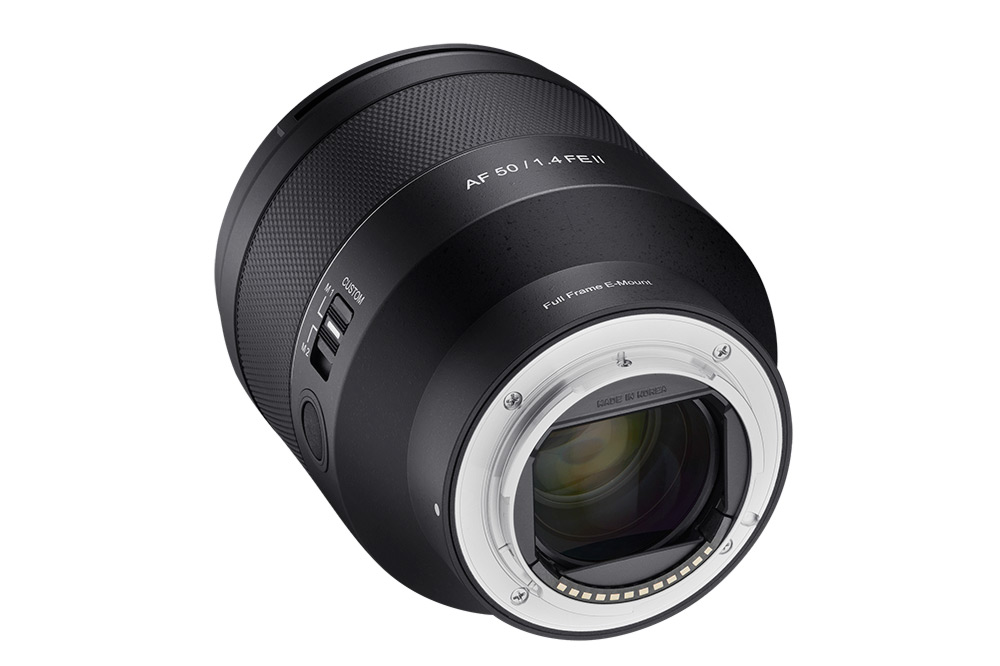- Call us: 01444 237070
- Contact Us
- Stores
- Sign In / Register
-
- Back
- Used Cameras
- Used Accessories
- Used Lenses
- Used Video
- Used Film Equipment
- Used Stock Alert
- Used Blank Test
- Sell or Part Exchange
- Used Clearance
- Recently Added Used Equipment
- Park Picks
- All Used Black Friday Deals
- Faulty
- Trade-In
- Blog
- New in
- Call us
- Contact us
- Stores
- Sign in
- Categories
- Tips & Inspiration
- Reviews
- News
- Events
- Features
- Buying Guides
- Competitions
Guide to Camera Lenses
Camera lenses are one of the most important factors to consider when taking your pictures and form a major element in the final aesthetic look of your photos. It can be difficult to choose the right one with so many different camera lenses available (as you can see in our huge range of lenses here), so making a smart choice can make a big difference to your photography enjoyment.

Table of contents
- What to Look for in a Camera Lens
- What Size Camera Lens Do I Need?
- What is Aperture?
- Fixed Aperture vs Variable Aperture Lenses
- Digital Camera Zoom Lens Explained
- Fixed Focal Length Lenses
- Camera Lens Filters
- Image Stabilisation Lenses
- Internal Focus Lens
This post is written to help you choose and discusses what to look for in a camera lens and what size you need. We also explain technical aspects and how they affect the outcome of your shots, like what aperture is and what the difference is between fixed and variable aperture.
Does your style of photography lend itself to a zoom or a fixed focal length, whether you make portraits, love street photography or just for snap shots. We also investigate if you need image stabilisation and when it’s useful. We’ll also touch on camera lens filters and how they can help you take your images and videos to the next level, with some pro tips and recommendations along the way.
What to Look for in a Camera Lens
Adding a new lens to your collection will breathe new life into your creativity, allowing you to capture new subjects, reach wider or further into the distance and even to enjoy new features. We explore what to look out for and how best to choose your next lens here.
Camera Lens Mounts
When you're looking at different camera lenses, the first thing to make sure of is that the lens will be compatible with your camera brand and then the camera itself. All camera brands have interchangeable lens cameras in their line-up, but these have different lens mounts based on whether it’s a DSLR or mirrorless and then the sensor size, with lenses made specifically for each. What we want to be sure of is that the lens mount corresponds with your camera body. There are lens mount converters, so you can mount a DSLR lens on a mirrorless camera for example, but that’s a bit more complicated so we will stick with ‘native lenses’.
The table below shows all of the main brands and which interchangeable lens cameras they make with the corresponding lens mount. We have concentrated on full frame, APS-C crop sensor and micro four thirds systems here, but also include the popular Fujifilm medium format system.
Camera brand lens mounts table
|
Camera brand |
Full frame DSLR |
APS-C DSLR |
Full frame mirrorless cameras |
APS-C mirrorless cameras |
Micro four thirds |
|
Canon |
N/A |
||||
|
Nikon |
N/A |
||||
|
Fujifilm |
N/A |
N/A |
N/A |
N/A |
|
|
Leica |
N/A |
||||
|
Sony |
N/A |
N/A |
E Mount (FE) |
E Mount |
N/A |
|
Olympus |
N/A |
N/A |
N/A |
N/A |
|
|
Panasonic Lumix |
N/A |
N/A |
N/A |
||
|
Pentax |
N/A |
N/A |
N/A |
||
|
Sigma |
N/A |
SA Mount |
N/A |
||
|
Fujifilm GFX |
The Fujifilm GFX medium format system uses a G Mount. |
||||
Image shows lens mount on a Samyang lens
Third Party Lenses
As well as manufacturer original brand lenses, there are a number of third party manufacturers who design options for each camera system. These can make for a great alternative, often at a more cost effective price point, despite offering innovative features and different optical designs. Typically, these brands all make lenses for various camera bodies, including DSLR and mirrorless options.
Third party manufacturers include:
Choosing a Suitable Focal Length
Once we’ve narrowed the lens down to the correct mount, we can consider what type of photography we enjoy, so that we pick a lens which is suitable for that style. There are no fixed rules for this choice, but there are broad considerations, with the most important being the focal length of the lens. There are specialist lenses which are ideal for specialist subjects that we touch on later.
Here’s a list of the naming conventions used for lens focal lengths:
- Ultra wide angle
- Wide angle
- Standard or normal
- Short telephoto
- Medium telephoto
- Super telephoto
The table below shows the main types (or genres) of photography which people often enjoy shooting. There are many, many others, some of which we cover in a more detailed table further on in this article here.
Types of photography lenses are used for:
|
Lens Focal Length (full frame) |
Name |
Typical types of photography |
|
Less than 21mm |
Ultra Wide Angle |
Architecture, Interiors and Astro |
|
21-35mm |
Wide Angle |
Landscape |
|
35-70mm |
Standard or Normal |
Street and Documentary |
|
70-200mm |
Medium Telephoto |
Portraiture |
|
200mm and over |
Super Telephoto |
Sports, Bird, Wildlife and Action |
Specialist Lenses
Outside of the main focal lengths there are specialist niche lenses, which work best for particular styles of photography that you might want to explore. These are:
- Fish eye - these create ultra-wide perspectives for a scene.
- Macro - these are very popular and come in various focal lengths from wide angle to short telephoto. The benefit of a macro lens is you can shoot close-ups, but also regular shots at the focal length. So a 50mm macro lens can also be used for any other standard subjects.
- Tilt shift - very specialist lenses used for architectural and product photography.
- Defocus lenses - these are also very niche and generally used by professionals for portrait photography.
- Video / Cine - while many ‘regular’ lenses can be used perfectly for video, there are also specific Cine lenses for pro film makers.
Each of these niche lenses creates a specific type of image, but on the whole they aren’t very versatile for shooting other subjects aside from the macro options.
Prime (Fixed Focal Length Lenses) or Zoom Lens
We cover this in more detail later in this article, however choosing a prime lens (fixed focal length) or a zoom can lend itself to different photography styles. A zoom lens can cover more focal lengths, making it easier to get more distant shots and helps if we can’t ‘zoom with our feet’. This basically means if we have a zoom subjects be closer or further away, whereas with a prime lens we have to move ourselves to get the right composition.
Photographers choose either primes or zooms depending on how and what they like to shoot. Primes will often be brighter with a wider aperture (let in more light) and often make us think more about the image we are making. Zooms tend to be more versatile, as we can shoot different subjects and can adjust compositions without having to move ourselves as much.
A good example is if we are into travel photography. A zoom lens is far more versatile as we can get away with bringing just one lens, rather than two or three prime lenses covering the same range. This means we can shoot architecture, cityscapes, street, portraits and capture closer action, as well as get general shots with say a 24-105mm, or 28-300mm for example. If we wanted prime fixed focal lenses to do the same, we would need a wide angle, a standard lens and a telephoto to cover the same opportunities.
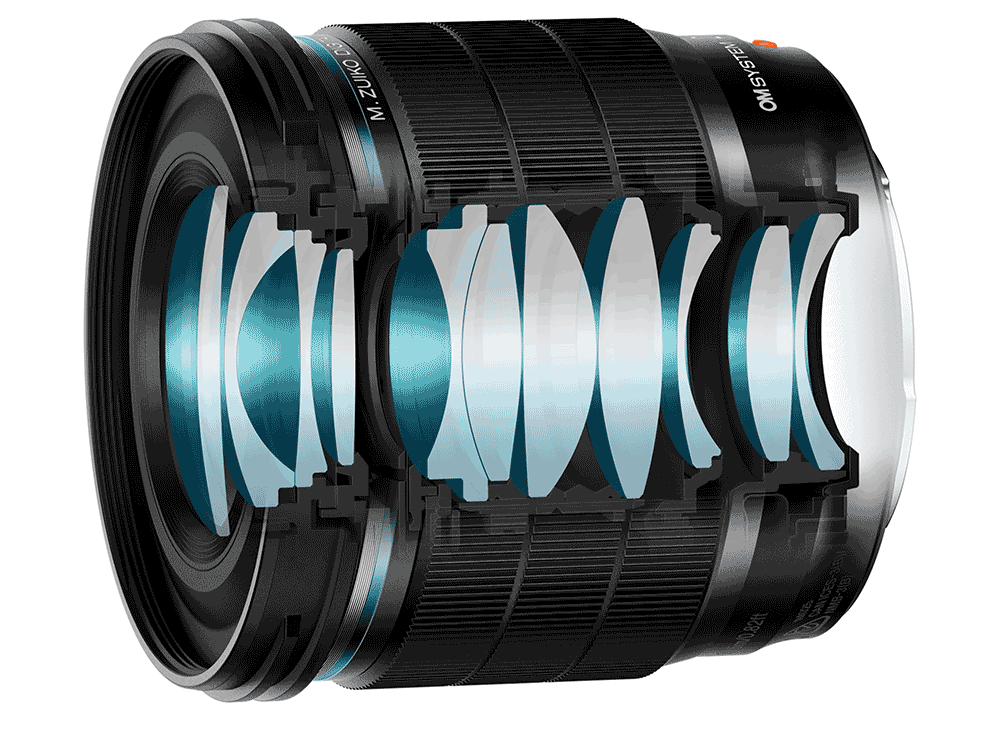
Illustration showing optical lens elements inside OM SYSTEM lens
Size and Weight of the Lens
Typically, full frame lenses tend to be bigger and heavier than crop and micro four thirds lenses. So if you have a smaller sensor size, the chances are you can get lighter lenses. This can make a big difference if you shoot for longer periods and have to carry your gear around. It’s the amount and type of glass inside the lens which tends to have the most influence over size and weight. The more glass, the heavier the lens will be, but you’ll also get better quality results on the whole, although this is not always the case. If you walk around a lot make sure you think about how much weight and how discreet the lens should be. Street photographers will often pick the smallest, lightest prime lenses they can. This keeps them discreet and lightweight for all day / night shooting. We talk about lenses in our best buys for street photography article here.
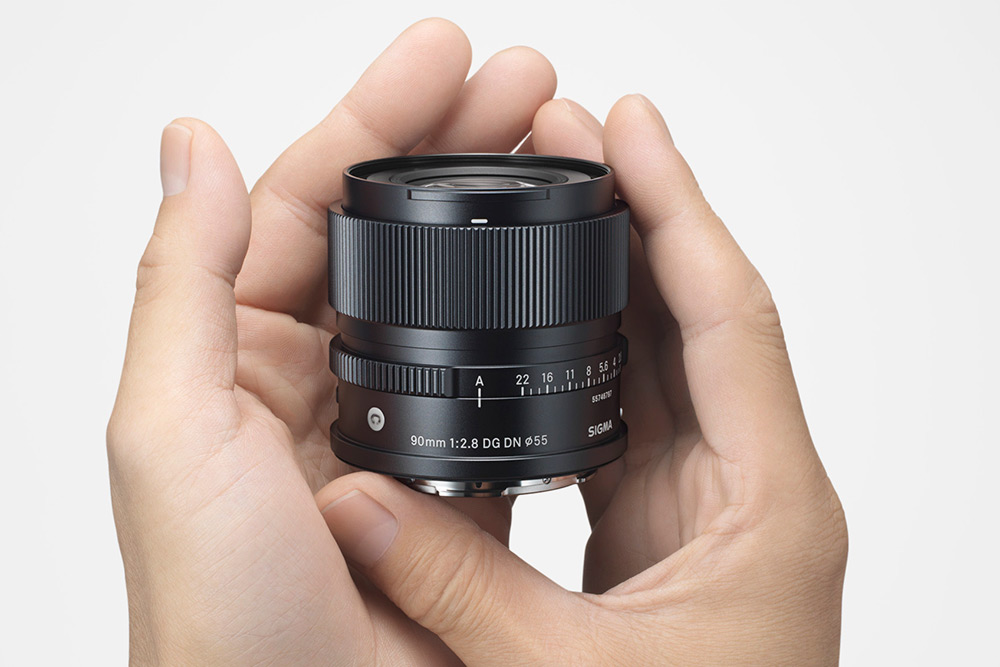
Ultra compact Sigma lens pictured. A smaller lens brings a number of benefits
Focus Types
The majority of lenses are capable of auto focusing as well as manual focusing these days, but some people still prefer manual focus-only, or at least the ability to choose manual focus if they want. We wrote about what the benefits of a manual focus lens are previously so won’t go into detail here, suffice to say it is worth double checking when you’re ready to place an order.
Maximum Aperture
The maximum aperture of a lens can make a difference to how shallow the depth of field can be in your images. We go into more detail below, but the aperture is well worth considering when buying a new lens.
If you predominantly shoot portraits, you’ll often want the most shallow depth of field possible, as your subject will stand out from the background. This means choosing a wide aperture lens (also referred to as faster or brighter). Very fast lenses will have large apertures of f/1.2 or f/1.4 (smaller numbers), gradually rising to f/4 or higher, which are slower lenses.
Another benefit of choosing a wide maximum aperture is that you’ll be gathering more light, which means you can shoot in darker, low light situations. This is useful for all sorts of subjects if you handhold the camera, including portraits, interiors, street, sunset photography, wildlife and many more.
Aperture Diaphragm Blades
You might want to think about the aperture in even more detail when buying your lens in terms of the aperture diaphragm opening and how many aperture blades there are. The most common are seven or nine blades, but we see 11 or even more sometimes. On the whole, if you love smooth out of focus areas in your images with nice rounded bokeh balls, the more aperture blades the better. If the blades are rounded you’ll get more rounded bokeh and smoother backgrounds too.
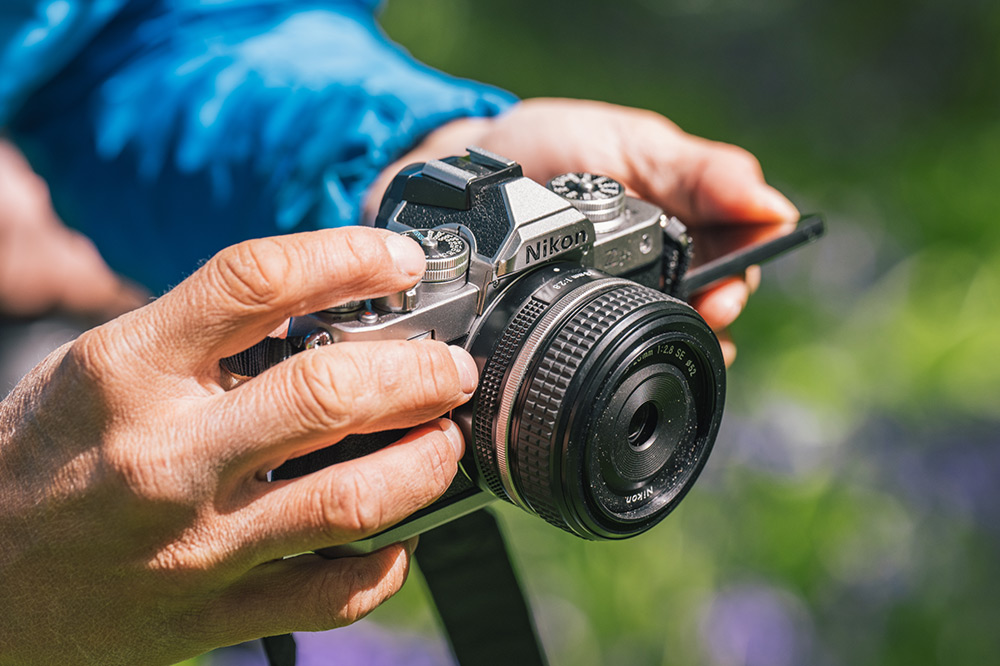
Lens Controls and Features
Camera lenses sometimes have a series of controls and buttons on them. These are added to help more advanced photographers streamline their shooting and make quick changes to how the lens works. Controls might include an autofocus switch, focus lock, programmable buttons, stabilisation settings and more. You will often also see a manual focus ring, an aperture ring and control ring. If you like to work quickly or choose your own custom settings, then look out for these on the lens you’re considering.
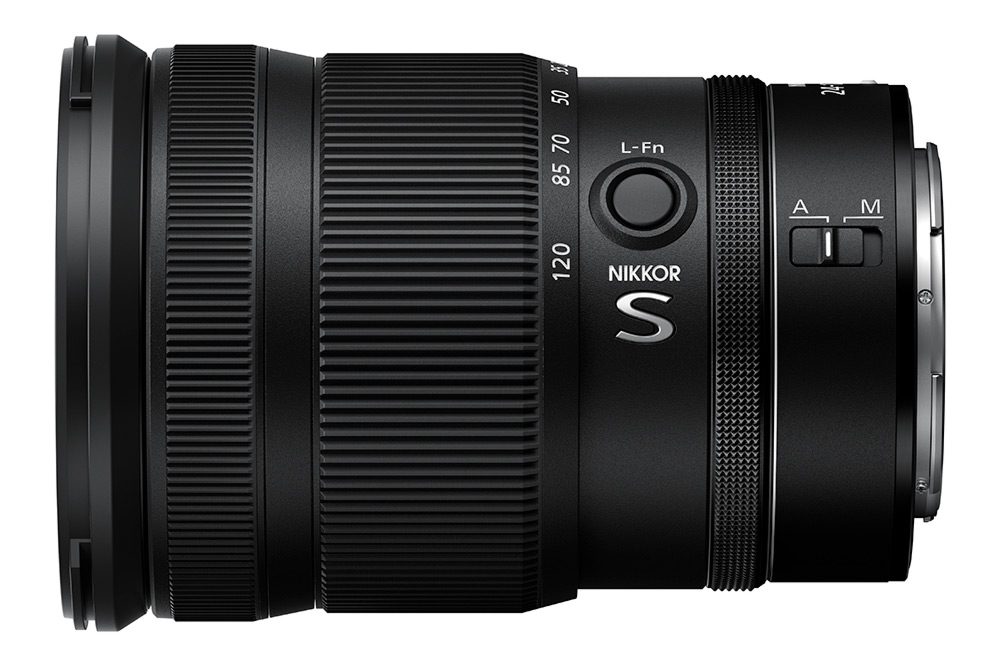
Nikon S-Line lens barrel controls with AF/MF and custom function button
Optical Lens Stabilisation
Another consideration is whether a lens has stabilisation built-in. Again we’ll look at this in more detail later here, but consider whether you handhold your camera a lot, shoot in low light situations or use a longer lens. If the answer is yes to any of these, you might want to get a lens with stabilisation, as it really can make a difference to getting sharp results in certain situations. Some cameras have IBIS (in body stabilisation), so optical lens-based stabilisation may not be such a factor.
Price
Your budget is a big consideration when buying a new lens. Typically, the better quality a lens is, the more expensive it will be and they can range in price from a couple of hundred pounds to several thousand.
Price factors include zooms vs primes, aperture speed, focal length, how many controls there are and whether it has stabilisation. The less common the focal length and the more features we see, the more a lens will typically cost.
The old adage is to spend as much as you can on your lenses, as you’ll be able to continue using them even if you upgrade your camera (if you stick with the same camera format). Lenses don’t have to be expensive though, with cost-effective options that are capable of amazing results available from all manufacturers.
What Size Camera Lens Do I Need?
The size (or focal length) of a lens generally tells you what subjects it will be good at capturing. The lower the number, the wider the lens is. This means you’ll get more in the frame but it will look further away. Conversely, the higher the number, the closer your subject will appear, but you’ll get less in the picture.
The table below suggests typical subjects which each size focal length is good for:
|
|
Wide angle |
Standard |
Telephoto |
Super Telephoto |
|
City / architecture |
✅ whole scene |
|
✅ details |
|
|
Food |
✅ whole plate |
✅ part of the plate |
|
|
|
Landscape |
✅ grand vistas |
✅ smaller scene |
✅ details |
✅ abstract |
|
Pet |
✅ environmental |
✅ portrait |
|
|
|
Portrait |
|
✅ portrait |
✅ closer portrait |
|
|
Sports / Action |
|
|
|
✅ close detail |
|
Still Life |
✅ whole scene |
✅ smaller scene |
|
|
|
Street |
✅ whole scene |
✅ smaller scene |
|
|
|
Travel / general |
✅ wide scene |
✅ snap shots / portraits |
|
|
|
Wildlife |
|
|
✅ portrait |
✅ more detail |
These are broad suggestions for choosing a focal length or size of lens, but consider that there is also a lot of crossover between lenses and the types of photography they are suitable for, with many exceptions. For example, if you like taking portraits, you might like taking environmental portraits of people in their place of work. A wide angle might be useful to capture the whole scene, but a wide angle isn’t the most common portrait lens, so it doesn’t appear with a tick.
Look for the most versatile lens for subjects you like to shoot when considering what size camera lens you want.
What is Aperture?
Lens aperture refers to the opening inside the lens, which lets light in to hit the sensor and make the image. The aperture is referred to in numbers on an f-stop scale such as f/5.6. The lower the number, the wider the aperture is. A wide aperture, (also referred to as fast or bright) lets in the most light, as the aperture opening is at its widest.
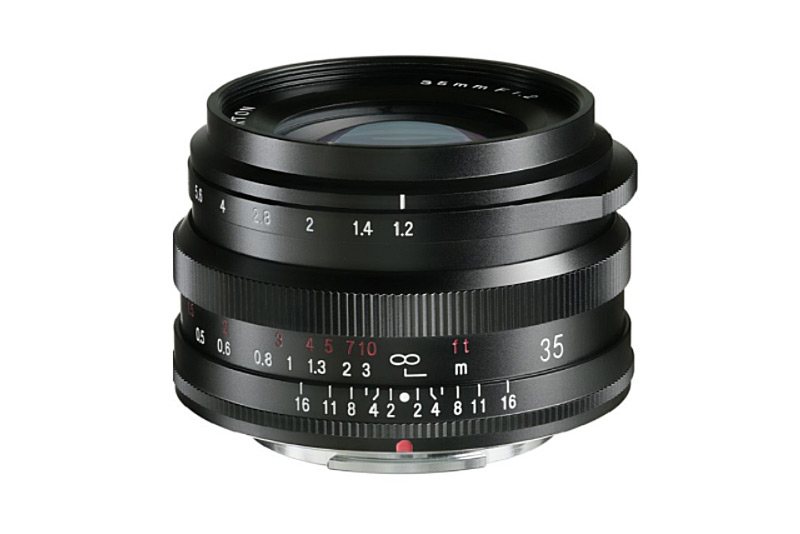
Aperture ring on Fujifilm X System lens
What Aperture Does in Photography
- A wide aperture lets in more light, so you can shoot in lower lighting conditions
- A wide aperture has a shallower depth of field with less in focus from front to back of the frame
- Conversely a narrow aperture has more in focus front to back. Landscape photographers will often use a narrow aperture in the region of f/11 to f/16 to get a lot of the scene in focus.
- A rounded aperture opening shows smooth rounded out of focus areas or ‘bokeh’ which many find pleasing.
- Aperture is one of three settings in the exposure triangle, affecting shutter speed and the ISO value. When the aperture is narrow (f/11 for example) less light enters the lens, so your ISO must be raised, or the shutter speed lowered accordingly.
There are some general guidelines for which aperture to use for different types of photography. Subjects where we want a lot of the frame in focus from front to back will usually require a narrower aperture such as f/8 or f/11. These can include cityscapes, architectural shots and landscapes. Popular lenses for these types of subjects include the Sony FE 16-35mm f/2.8 GM Wide Angle Zoom Lens and Fujifilm XF 27mm f/2.8 R WR Lens Black.
If on the other hand we shoot portraits, pet photos or artistic food photos, we might want less of the image in focus, just to concentrate the viewer on a part of the subject, rather than a distracting background. This is where we would choose a wider aperture such as f/1.8, which gives us a shallow depth of field. This creates separation between our subject and the background and has a big impact on where the viewer looks. A popular model for Canon's mirrorless EOS R system is the Canon RF 50mm f/1.8 STM Prime Lens.
Playing around with aperture is a great way to learn about photography when we start out. Take the same shot at different aperture settings and see what the results look like. The more you practice this the more control you will have over the final result.
Fixed Aperture vs Variable Aperture Lenses
Prime (fixed focal length) lenses will always have a fixed aperture, whereas zoom lenses can either have a fixed aperture or a variable aperture.
This means at the widest end of a zoom lens, you will be able to use a wider aperture, and somewhere in the zoom range the aperture will creep up to the next value in the f-stop scale. Examples of variable apertures might be f/2 to f/2.8, f/4.5 to f/6.3 and f/4.5 to f/5.6. There are zoom lenses which have a fixed aperture. Commonly each camera manufacture produces a series of three ‘Holy Trinity lenses’ which will have a fixed f/2.8 aperture throughout the entire zoom range. These will be more expensive than variable aperture counterparts, as the glass inside them is larger, heavier and more difficult to produce.
What are the Advantages of Fixed or Variable Aperture Zoom Lenses?
A fixed aperture zoom lens allows you to shoot at wider apertures throughout the zoom range. This affords the benefits listed above, with better low light capabilities and a shallower depth of field.
A variable aperture zoom has benefits too though as they will typically be smaller, lighter and cheaper, and can also have broader zoom ranges.
Digital Camera Zoom Lens Explained
Arguably the most versatile lens you can get for your digital camera is a zoom lens. This is because you can compose without needing to move as much as if you have a prime fixed focal length lens.
Zoom lenses will be able to literally zoom closer to your subject and are used by amateurs through to professional photographers. They generally fall into similar category names as used in the tables above. Zoom categories include:
- Ultra wide angle zoom
- Wide angle zoom
- Standard or normal zooms
- Medium telephoto zooms
- Super telephoto zooms
Choosing a zoom lens should be done according to the style of photography you will mostly shoot with it. There’s no point buying an ultra wide angle zoom lens if you enjoy bird photography, as your subject will be tiny in the frame, rather get a super telephoto zoom instead.
We also find special superzoom or broad range zoom lenses, which cover focal ranges across these foal width categories. There are many of these available for photographers, typically appealing for travel or general purpose uses. Some favourite zoom options include:
- Sony FE 200-600mm f/5.6-6.3 G OSS Lens
- Sony FE 24-105mm f/4 G OSS Zoom Lens
- Fujifilm XF 70-300mm f/4-5.6 R LM OIS WR Lens Black
- Olympus 100-400mm f/5-6.3 ED M.ZUIKO Lens Black
- Canon RF 100-500mm f/4.5-7.1 L IS USM Lens
- Sigma 150-600mm f/5-6.3 DG OS HSM Contemporary Lens Nikon F
- Sigma 150-600mm f/5-6.3 DG OS HSM Contemporary Lens Canon EF
- Nikon Nikkor Z 24-200mm f/4-6.3 VR Telephoto Zoom Lens
- Canon RF 24-105mm Lens f/4 L IS USM
- Olympus M.Zuiko Digital ED 40-150mm f/2.8 PRO Telephoto Zoom Lens
Some of our favourite superzoom or wide range zooms options are the Tamron 35-150mm f/2-2.8 Di III VXD Lens for Sony E, Tamron 18-300mm f/3.5-6.3 Di III-A VC VXD Lens for Fujifilm X
Nikkor Z DX 50-250mm f/4.5-6.3 VR lens, the 2021 Nikon Nikkor Z DX 18-140mm f/3.5-6.3 VR Lens and Panasonic Lumix S 70-300mm f/4.5-5.6 Macro O.I.S. Lens for L mount. These give you a great degree of versatility to shoot lots of different types of subjects.
Fixed Focal Length Lenses
There is a core of photographers, again from beginner to professional, who swear by using fixed focal length lenses, also called prime lenses. Some of the most popular lenses of all time are primes, including timeless 50mm and 35mm lenses which are available from all lens manufacturers. We look at ‘why use a 35mm lens’ here in our blog, as well as 50mm lenses here.
There are several benefits to using a prime fixed focal length lens:
- They tend to be smaller and lighter than similar length zoom lenses. This is because they have less optical elements inside, and cannot zoom. Smaller and lighter = easier to work with, more discreet and lighter to carry around all day.
- Fixed focal length lenses will often have a wider, or brighter aperture than an equivalent zoom lens. With less glass lens and less zooming designers can create a wider aperture opening. This provides the benefits outlined above such as better low light performance and a shallower depth of field to isolate your subject.
- Sharper results. Traditionally prime lenses can result in sharper images. This is in part because of one or a combination of reasons. Perhaps they are smaller and lighter, can shoot faster, or have less lens elements to diffract the light. The gap is closing between sharpness in fixed focal lengths and zooms today as optical engineering advances, but many photographers still use prime lenses when they need the absolute sharpest results possible.
- Less distortion. A prime lens will typically show less distortion and give more natural results than zoom lenses, because the lens has to do less work.
- Lower cost. A prime will tend to cost less than a zoom, as there is less glass inside, no zoom mechanism and so on. You can find incredibly expensive fixed focal length lenses of course, as manufacturers will often use a prime as their ‘showpiece’ for what they can achieve optically. Typically though, prime lenses are more cost effective.
- A more immersive experience. Many photographers who enjoy the experience of photography will be drawn to a prime lens. This is because it makes you think more about your composition because you have to move yourself, rather than simply zooming a ring. You will become more skilled at one single focal length, rather than an entire zoom range, which gives you more experience and a more trained eye at that one length. This isn’t a given and of course not everyone feels that way, but it is a common theme amongst photographers.
You can shoot literally any subject with a fixed focal length lens and will be able to find ultra wide primes, standard primes and super telephoto prime lenses for your camera. That said, some photographers will lean towards a prime for certain subjects. These include street photography where a slightly wide or standard prime lens will be extremely popular, such as a 35mm lens or a 50mm lens.
Similarly, an 85mm has traditionally been extremely popular with portrait photographers. That’s because of the background separation which you get with a short telephoto, without the compression of a super telephoto lens, or distortion from a wide angle. Photo journalists and documentary photographers might lean towards a standard or normal length, so as to avoid any lens distortion and offer the most natural field of view.
If you are lucky enough to be able to afford a prime lens for bird photography or wildlife photography, you will be using some of the most accomplished lenses available, with absolutely huge 400mm f/2.8 and 600mm f/4 lenses. Micro four thirds users fall into the lucky category because their super telephoto lenses can be considerably smaller and lighter even at those lengths. Meanwhile Canon shook up the mirrorless market with two absolutely affordable 600mm and 800mm full frame lenses which are smaller and lighter than virtually anything seen before.
These are the RF 600mm and RF 800mm.
Some of most popular primes are:
- Sony FE 20mm f/1.8 G Ultra Wide Angle Prime Lens
- Fujifilm XF 35mm f1.4 Standard Prime Lens
- Nikon 50mm f/1.8 S Z Mount Lens
- Sony FE 85mm f/1.4 GM Prime Lens
- Nikon AF-S Nikkor 50mm f/1.8G Standard Prime Lens
- Sigma 35mm f/1.4 DG HSM Art Lens Sony E
- Canon RF 16mm f/2.8 STM Lens
- Fujifilm XF 33mm f/1.4 R LM WR Lens
- Panasonic Lumix G Macro 30mm f/2.8 ASPH MEGA O.I.S. Lens Black
- Sigma 35mm f/2 DG DN Contemporary Lens For L Mount
Camera Lens Filters
The results which a lens can achieve can be enhanced under certain conditions by using a camera lens filter. Lenses vary in size due to the various focal lengths and apertures they offer, which in turn affects the size of the front element and therefore the filter thread size. The size of the filter to use will change accordingly and is usually marked on the front of the lens with a φ mark. Filter threads start as small as 37mm for and go up to 105mm for large aperture telephoto lenses. You should get the correct size for the lens thread so that it fits properly. Some companies such as SIGMA will include optical coatings to reduce the mount of light which can enter the filter, suppressing flare and ghosting without a negative impact on the final results.
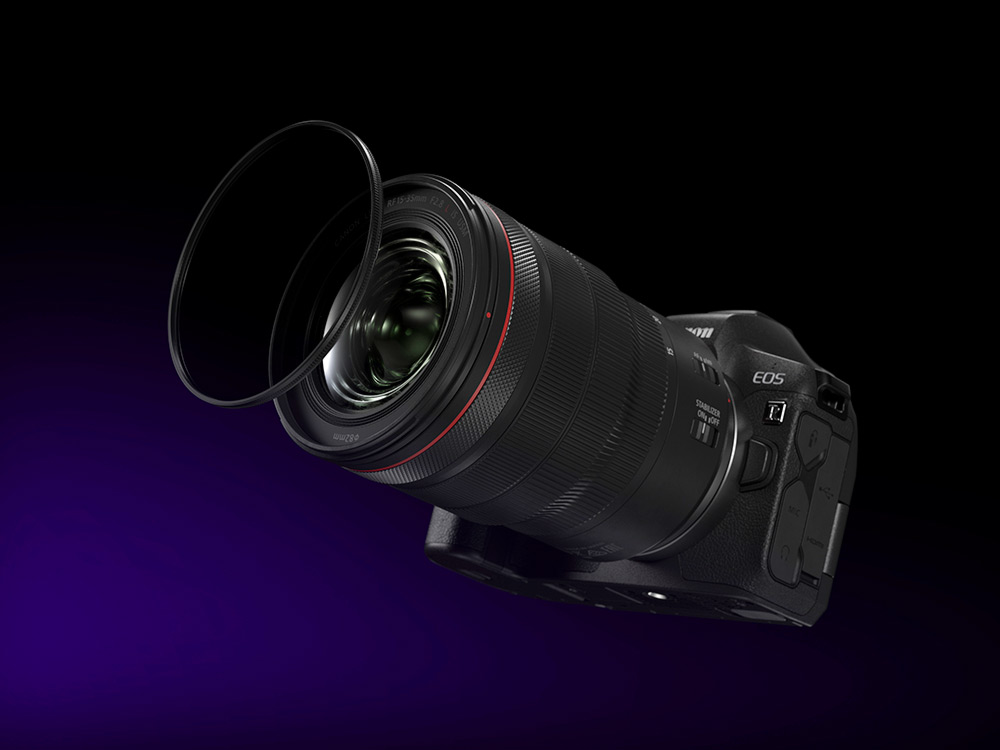
Image showing adding a filter to a Canon lens
There are four main filter types, with lots of variations, different qualities and options for photography.
Protection Filters
A protection filter is the most basic in terms of what it does, which is simply to protect the front element of the lens from dirt, dust, fingerprints and accidental damage. A good quality protection filter should not affect the colour of the shot, nor reduce the amount of light or change the image in any way. Because of this it can typically be left on your lens all of the time.
UV Filters
UV filters are designed to reduce the effects of ultraviolet light, but also perform the task of protecting the front lens element. An ultraviolet UV filter should have little to no effect on regular image making and won’t change the amount of light entering the optics, nor the colour of the final result.
They should however reduce the blueish effect which is caused by UV light and enhance the image in a subtle way. Some argue they don’t do much to change the outcome, which is true in many situations. Where they are most effective aside from protecting your lens, is over longer distances, where your subject might be quite a way off.
Polarising Filters
Polarising filters go by various names including circular polariser, CPL or just polariser. They perform a vital primary task in outdoor photography, which is to reduce the amount of reflections caused by wet surfaces. For this reason they are essential for landscape photographers in particular.
Wet surfaces might include a body of water such as rivers, lakes and the sea, where twisting a polariser can allow you to see through the reflective surface of the water. They will also reduce the whiteish glare from wet foliage, which can make a huge difference to forest / tree shots, even grass or wet rocks. The overall saturation and contrast of an image can be adjusted when shooting wet reflective surceases with a simple twist of a polariser.
Another effect which a CPL can have is to make blue skies more blue. You have to be at the right angle for this to work, but the effect can be dramatic. It stands to reason that photographers who shoot architecture and even portraits sometimes use a polarising filter for these reasons, gaining image integrity, contrast and reducing glare.

High quality HOYA circular polarising filter example
ND Filters
Neutral density filters (or ND) come in various guises, with different types that are either graduated, solid or variable. They are used for both photography and videography to reduce the amount of light entering the lens, ideally without creating too much colour cast.
Graduated ND Filters
These are as the name suggests graduated from top to bottom with a dark area transitioning to a light area. The idea of a graduated ND filter is to compensate for a brighter area in the frame, typically the sky verses a darker ground below.
Solid ND Filters
A solid neutral density filter will reduce the amount of light evenly across the entire frame. These are used primarily for long exposure effects or for video.
Variable ND Filters
These are the most versatile as they offer the user a variable amount of light blocking capabilities. This makes them invaluable for videography as well as photography where we want more versatility than a single filter.
As optical technology advances there are new combinations of filters appearing, such as variable ND filters combined with smoothing effects, or ND and polarisers combined. This is an exciting time to be shooting movies and landscapes with these options.
Filter Systems
As well as individual filters there are comprehensive filter systems from leading manufacturers such as LEE Filters and Cokin. These are extremely popular, providing unique holders to attach various filters onto your lenses and offer a degree of flexibility and control which individual filters aren’t always able to do.
Image Stabilisation Lenses
We touched on image stabilisation earlier in this article and go into more detail here for you. In 2021 leading manufactures can give us a huge advantage with lens-based image stabilisation.
Some Canon RF lenses will provide up to 8 f-stops of anti-shake reduction when combined with a compatible camera body, which is quite staggering. These include the popular RF 24-70mm f/2.8L and RF 70-200mm f/2.8L. The number of stops refers to how many stops of light are being compensated for, so the higher the image stabilisation number, the steadier the camera will be at slower speeds.

Canon lens IS (Image stabilisation) system diagram
Let’s take a real-life example. You want to take a photo of a bird in a tree with a telephoto lens. A telephoto will usually be a bit longer and heavier than a shorter standard lens, so it wobbles around a bit more.
If the light is quite low, you might find that the image is underexposed when you shoot at f/8. at a speed of 1/1000 (which you’re using to get the bird sharp). So you either have to crank the ISO to very high numbers and sacrifice image quality, or slow the shutter speed. If you shoot at a slow speed, you’ll see the image is not sharp as there is motion blur from even a tiny movement.
Enter lens stabilisation. If you have 5-stops of image stabilisation, you’ll be able to lower the shutter speed to 1/15 sec and capture the same sharpness as if you were at 1/1000 sec. You’ll still need to keep the camera and lens as steady as possible using best practice, but stabilisation really does work.
Each manufacture refers to lens-based stabilisation in different ways, which is often abbreviated in the name:
- Canon - Image Stabiliser or IS
- Fujifilm - Optical Image Stabilisation or OIS
- Nikon - Vibration Reduction or VR
- Olympus - Image Stabilisation or IS
- Panasonic Lumix - POWER O.I.S
- Pentax - Shake Reduction or SR
- Sony - Optical SteadyShot or OSS
- Sigma - Optical Stabilisation or OS
- Tamron - Vibration Compensation or VC
Internal Focus Lens
An internal focus lens is an optical design where focus is changed by moving the inner lens group (or groups) without rotating or shifting the front lens element. This is typically found in mid to high-end models. There are some benefits to having an internal focus lens:
- There will be no rotational movement to the front element allowing the use of graduated filters and circular polariser filters without the need for re-adjustment after focusing
- Autofocus is often quicker with IF lenses
- Manual focus throws can be shorter with internal focus lenses
- Petal shaped hoods will remain in the correct orientation during focusing
- When you are very close to a subject, the lens does not protrude any closer, which is useful for macro photography in particular
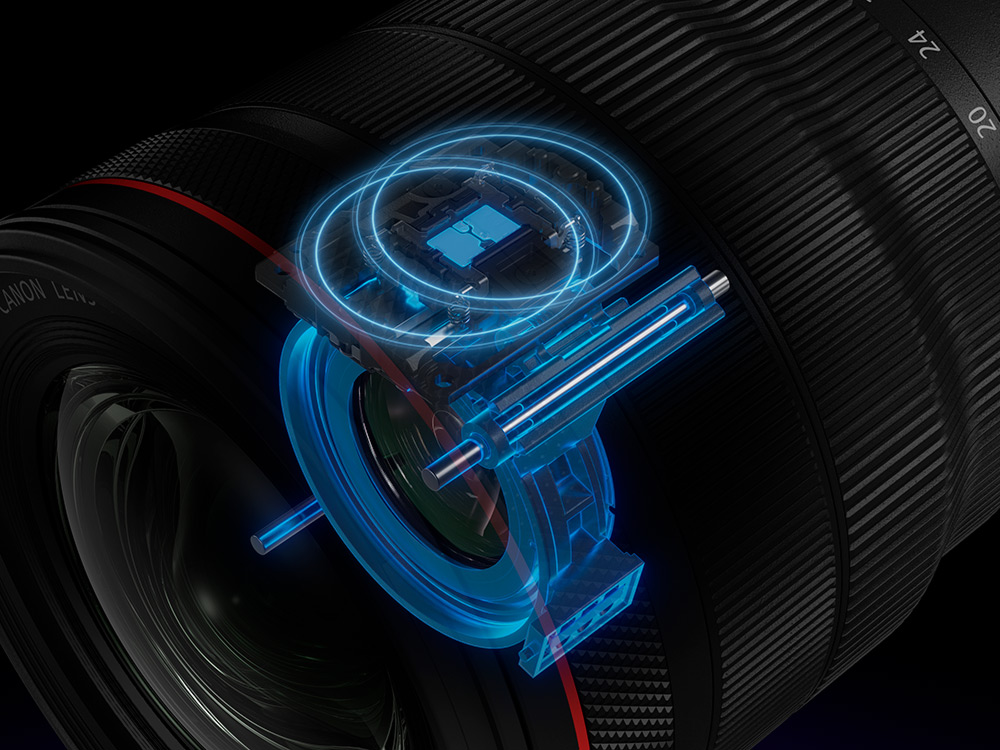
Canon lens USM focus motor diagram
What do the numbers and letters in a camera lens name mean?
The sequence of numbers and abbreviations can be quite confusing when you first look at camera lens names. Despite this it’s a good idea to understand them so that you can make a well informed choice when you’re buying one. Every manufacturer includes their own proprietary abbreviations, but to at least two essential parts are usually displayed in the same way by all manufacturers. The first is the focal width, which is normally followed by mm and the second is the maximum aperture on the f-stop scale, which the lens can open to.

Let’s take the Canon RF 100-500mm f/4.5-7.1 L IS USM Lens as an example.
The focal length of the lens is followed by ‘mm’ so this lens name shows us that we have a zoom capability, with a range between 100mm and 500mm. After this you’ll see ‘f/‘ or simply ‘F' followed by some numbers. These refer to the widest aperture the lens is capable of reaching (which can also be described as maximum aperture or fastest aperture). As this is a variable aperture zoom lens we have a range of f/4.5 to f/7.1. The lowest number in a variable aperture zoom lens will be the widest aperture when the lens is at its widest (not zoomed in at all), which is f/4.5 at 100mm here. The second number is the widest aperture when the lens is fully zoomed in, which happens to be f/7.1 at 500mm on this Canon model.
The letters in the lens name from our example refer to all of the elements discussed in this buying guide. They start off with lens mount compatibility, which is in this case is ‘RF’ - or Canon full frame mirrorless lenses. Immediately after the aperture range we see ‘L IS USM’. The L signifies canon’s Luxury range, or professional range of lenses. IS refers to image stabilisation and USM is an abbreviation for the Ultrasonic Motor. This is arguably Canon’s most widely used Autofocus motor, which helps the lens to achieve quick and accurate focusing.
All manufacturers will provide the focal width and maximum aperture, together with any special features the lens offers. Just to reiterate in this example the name describes the focal width, maximum aperture, professional range, stabilisation and focus motor type. This lets the photographer know everything they need in order to establish roughly how they can expect the lens to perform, although we would always recommend reading and watching our photography gear reviews too!
Hopefully this article shows how important choosing the right lens for you and your style of photography is. There are a lot of considerations and choices, aside from fitting correctly onto your camera. What subjects will you photograph? How light do you want your gear to be? Do you need features like image stabilisation and customisation options? Will you shoot many low light subjects and do you want a wide aperture to separate your subject from the background?
Most people who get the photography bug end up getting more than one lens as they develop their style and shoot a wider variety of subjects. You might end up getting one of two fixed focal length lenses along with a zoom lens and a telephoto zoom. Having more options in your collection allows you to use the best one according to what you will be photographing and not get frustrated that you didn’t have a choice when a new subject presented itself.
Our fully trained staff are always available to answer any questions and our stores also give you the chance to try out different models to help make your mind up. Whichever you end up getting, we hope you enjoy developing your passion for photography and get the most out of this fantastic hobby. Why not take a look through more of our camera gear buying guides here for useful information to help you make an informed choice when looking to buy any photography equipment.
Share this post:
By Nick Dautlich on 10/11/2021
Nick Dautlich
Senior Content Writer and Product Reviewer
Nick Dautlich is the Senior Content Writer and Product Reviewer at Park Cameras, with over 15 years of photography experience. A Sony Imaging Professional and expert reviewer, Nick has worked with major brands such as Canon, Sony and Nikon. His work is also featured on Vanguard World UK’s website, Capture Landscapes, and Shutter Evolve. Nick’s photography includes National Trust projects and magazine covers and he is passionate about landscapes and storytelling. Nick also enjoys hiking and teaching his children about nature. Learn more on his profile page.

Trade in your old equipment
Fast and easy trade in service ensures your old gear is collected efficiently and you are paid quickly! It's very simple to trade in your unwanted photography gear. Just head over to our dedicated Sell or Part Exchange page, fill out the details, and we'll get back to you with an offer for your old gear. Take the cash, or put it towards the cost of your new gear. It's up to you! Find out more
sign up to the newsletter
Keep up to date on the latest photography news, events and offers. Sign up now

